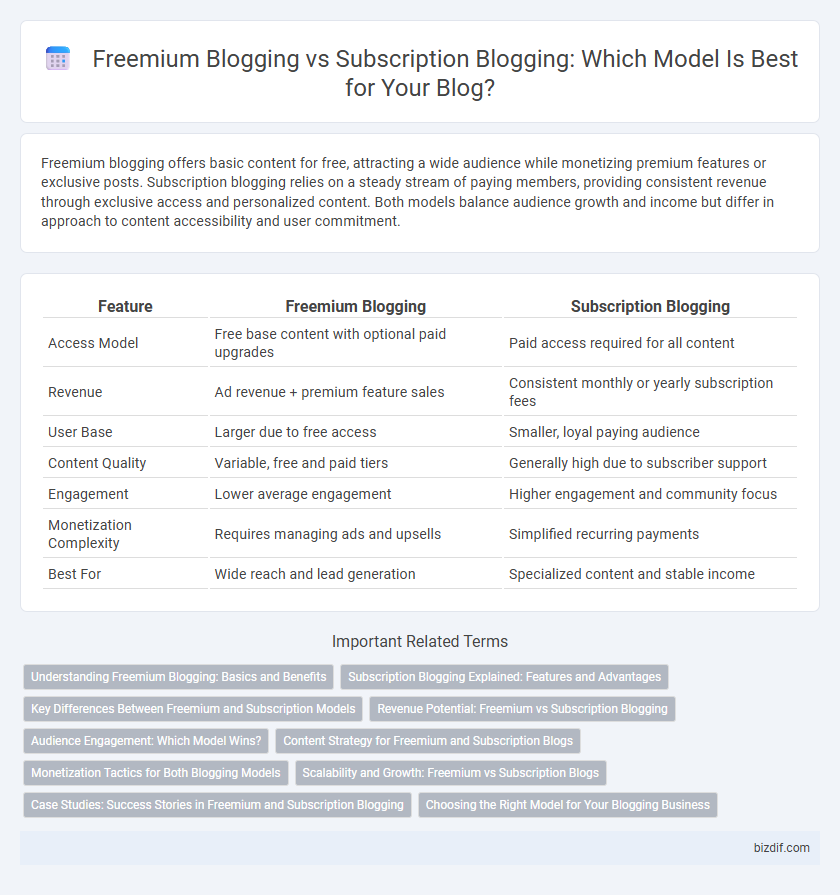Freemium blogging offers basic content for free, attracting a wide audience while monetizing premium features or exclusive posts. Subscription blogging relies on a steady stream of paying members, providing consistent revenue through exclusive access and personalized content. Both models balance audience growth and income but differ in approach to content accessibility and user commitment.
Table of Comparison
| Feature | Freemium Blogging | Subscription Blogging |
|---|---|---|
| Access Model | Free base content with optional paid upgrades | Paid access required for all content |
| Revenue | Ad revenue + premium feature sales | Consistent monthly or yearly subscription fees |
| User Base | Larger due to free access | Smaller, loyal paying audience |
| Content Quality | Variable, free and paid tiers | Generally high due to subscriber support |
| Engagement | Lower average engagement | Higher engagement and community focus |
| Monetization Complexity | Requires managing ads and upsells | Simplified recurring payments |
| Best For | Wide reach and lead generation | Specialized content and stable income |
Understanding Freemium Blogging: Basics and Benefits
Freemium blogging offers free access to basic content while generating revenue through premium features or exclusive posts, attracting a broader audience and encouraging user engagement. This model allows bloggers to build a loyal following by providing value upfront, increasing the likelihood of converting casual readers into paying subscribers. Key benefits include scalable growth, enhanced community building, and diversified income streams without restricting initial content accessibility.
Subscription Blogging Explained: Features and Advantages
Subscription blogging offers a steady revenue stream by charging readers for exclusive content, fostering a loyal community around niche topics. Core features include gated articles, member-only forums, and personalized newsletters that enhance user engagement and retention. This model provides bloggers with financial stability and deeper audience insights, enabling tailored content strategies and sustained growth.
Key Differences Between Freemium and Subscription Models
Freemium blogging offers free access to basic content while charging for premium features or exclusive materials, attracting a wider audience and encouraging upgrades. Subscription blogging requires users to pay regularly for full access, providing steady, predictable revenue and fostering a committed community. The key differences lie in monetization strategies, audience reach, and user engagement, with freemium focusing on conversion potential and subscription emphasizing consistent income.
Revenue Potential: Freemium vs Subscription Blogging
Freemium blogging offers revenue potential through a large user base attracted by free content, monetized via ads, affiliate marketing, or paid upgrades, while subscription blogging generates steady, predictable income via recurring fees from dedicated readers. Subscription models tend to yield higher lifetime value per customer and promote stronger community engagement, essential for sustainable growth. Balancing traffic volume in freemium with conversion rates in subscription models is crucial for optimizing overall blogging revenue strategies.
Audience Engagement: Which Model Wins?
Freemium blogging attracts a broader audience by offering free access to basic content while encouraging upgrades for premium features, driving higher initial engagement. Subscription blogging fosters a more dedicated community through exclusive, high-quality content that builds deeper connections and consistent interaction. Audience engagement ultimately depends on content value and targeted strategies rather than the model alone.
Content Strategy for Freemium and Subscription Blogs
Freemium blogging leverages a mix of free high-value content and premium paid materials to attract a broad audience while converting loyal readers into paying subscribers. Subscription blogging emphasizes exclusive, in-depth content and personalized experiences to retain subscribers and ensure steady revenue streams. Effective content strategy for freemium models balances accessibility and exclusivity, whereas subscription blogs prioritize consistent, high-quality, and member-only content to drive engagement and reduce churn.
Monetization Tactics for Both Blogging Models
Freemium blogging leverages a dual-tier approach by offering free content to attract a broad audience while generating revenue through premium features, exclusive articles, or ad placements. Subscription blogging focuses on consistent, recurring income by providing members-only access, in-depth content, or community engagement, often using platforms like Patreon or Substack. Effective monetization tactics include targeted upselling in freemium models and tiered subscription plans that incentivize higher levels of support in subscription models.
Scalability and Growth: Freemium vs Subscription Blogs
Freemium blogging offers scalability by attracting a large user base through free content while monetizing advanced features, enabling organic growth and wider audience reach. Subscription blogging ensures steady and predictable revenue streams, fostering sustainable growth by focusing on high-quality, exclusive content that encourages loyalty and reduces churn. Balancing freemium's rapid scalability with subscription's consistent income can optimize long-term blog growth strategies.
Case Studies: Success Stories in Freemium and Subscription Blogging
Case studies reveal that freemium blogging models, such as those employed by HubSpot and Moz, successfully drive massive user acquisition by offering valuable free content with premium upgrade options, resulting in robust community growth and revenue streams. Subscription blogging examples like Substack and Patreon demonstrate consistent monthly income by fostering loyal audiences through exclusive, high-quality content tailored to niche markets. Data from these cases emphasize the importance of balancing free offerings and paid content to maximize engagement, retention, and monetization in both blogging models.
Choosing the Right Model for Your Blogging Business
Choosing the right blogging model depends on your audience engagement and revenue goals; freemium blogging offers free content with premium paid upgrades, maximizing user reach while monetizing loyal readers. Subscription blogging generates consistent income through exclusive, member-only content, ideal for creators with a dedicated community willing to pay regularly. Analyze factors such as content value, audience size, and marketing strategy to balance growth potential with sustainable earnings.
Freemium Blogging vs Subscription Blogging Infographic

 bizdif.com
bizdif.com